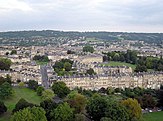The buildings and architecture of Bath, reveal significant examples of the architecture of England, from the Roman Baths (including their significant Celtic presence), to the present day. The city became a World Heritage Site in 1987, largely because of its architectural history and the way in which the city landscape draws together public and private buildings and spaces. The many examples of Palladian architecture are purposefully integrated with the urban spaces to provide "picturesque aestheticism". It is the only entire city in Britain to achieve World Heritage status, and is a popular tourist destination.
Important buildings include the Roman Baths; neoclassical architect Robert Adam's Pulteney Bridge, based on an unused design for the Rialto Bridge in Venice; and Bath Abbey in the city centre, founded in 1499 on the site of an 8th century church. Of equal importance are the residential buildings designed and built into boulevards and crescents by the Georgian architects John Wood, the Elder and his son John Wood, the Younger - well-known examples being the Royal Crescent, and The Circus.
Most of Bath's buildings are made from the local, golden-coloured, Bath Stone. The dominant architectural style is Georgian, which evolved from the Palladian revival style that became popular in the early 18th century. According to UNESCO the architecture of the city provides... "an integration of architecture, urban design, and landscape setting, and the deliberate creation of a beautiful city". Development during modern eras, including the development of the transport infrastructure and rebuilding after bomb damage during World War II, has mostly been in keeping with earlier styles to maintain the integrated cityscape. (Full article...)
